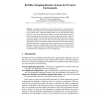Free Online Productivity Tools
i2Speak
i2Symbol
i2OCR
iTex2Img
iWeb2Print
iWeb2Shot
i2Type
iPdf2Split
iPdf2Merge
i2Bopomofo
i2Arabic
i2Style
i2Image
i2PDF
iLatex2Rtf
Sci2ools
DSVIS
2008
Springer
2008
Springer
ReWiRe: Designing Reactive Systems for Pervasive Environments
The design of interactive software that populates an ambient space is a complex and ad-hoc process with traditional software development approaches. In an ambient space, important building blocks can be both physical objects within the user's reach and software objects accessible from within that space. However, putting many heterogeneous resources together to create a single system mostly requires writing a large amount of glue code before such a system is operational. Besides, users all have their own needs and preferences to interact with various kinds of environments which often means that the system behavior should be adapted to a specific context of use while the system is being used. In er we present a methodology to orchestrate resources on an abstract level and hence configure a pervasive computing environment. We use a semantic layer to model behavior and illustrate its use in an application.
Ambient Space | DSVIS 2008 | Human Computer Interaction | Important Building Blocks | Software Development Approaches |
Related Content
| Added | 19 Oct 2010 |
| Updated | 19 Oct 2010 |
| Type | Conference |
| Year | 2008 |
| Where | DSVIS |
| Authors | Geert Vanderhulst, Kris Luyten, Karin Coninx |
Comments (0)

